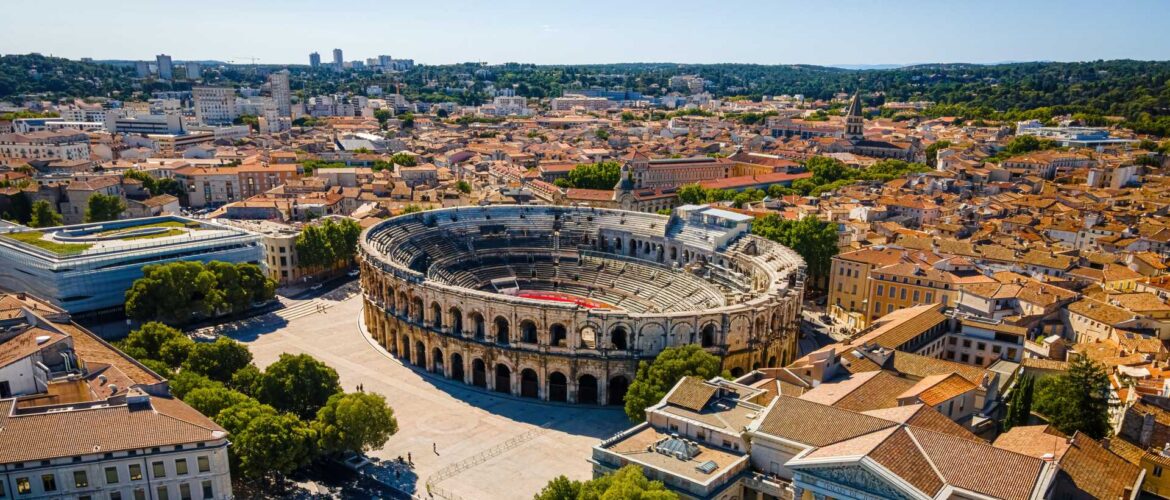Nîmes, an iconic city in southern France, enchants visitors with its rich ancient heritage and unique atmosphere. This former Roman city with an exceptional history takes you on a journey through time thanks to its perfectly preserved monuments, including the famous Arena and Maison Carrée.
Stroll through the narrow streets, explore the historical sights or attend a performance in the amphitheatre and discover a city where the past still dialogues with the present. In this article, we take you to the heart of Nîmes, from its history to its must-see sights, and give you some tips on how to make the most of your visit from our holiday home, just an hour’s drive away.
History of the city of Nîmes: its origins as a Roman city
Nîmes has its roots in Antiquity, when a small Gallic settlement became one of the most iconic cities of the Western Roman Empire. Thanks to its strategic location between the Mediterranean Sea and the inland areas of France, the city prospered rapidly and acquired public buildings of remarkable quality, now considered among the best-preserved Roman monuments in France.
The history of Nîmes is closely linked to this period: the Romans developed a structured urban layout and a sophisticated network of aqueducts – including the Pont du Gard – which carried water nearly 50 km from the Fontaine d’Eure in Uzès to supply a city often affected by local drought. This long history has shaped the face of Nîmes, which remains today one of the major destinations for understanding the Roman settlement in the south of France.
The Arènes de Nîmes: an exceptional theatre
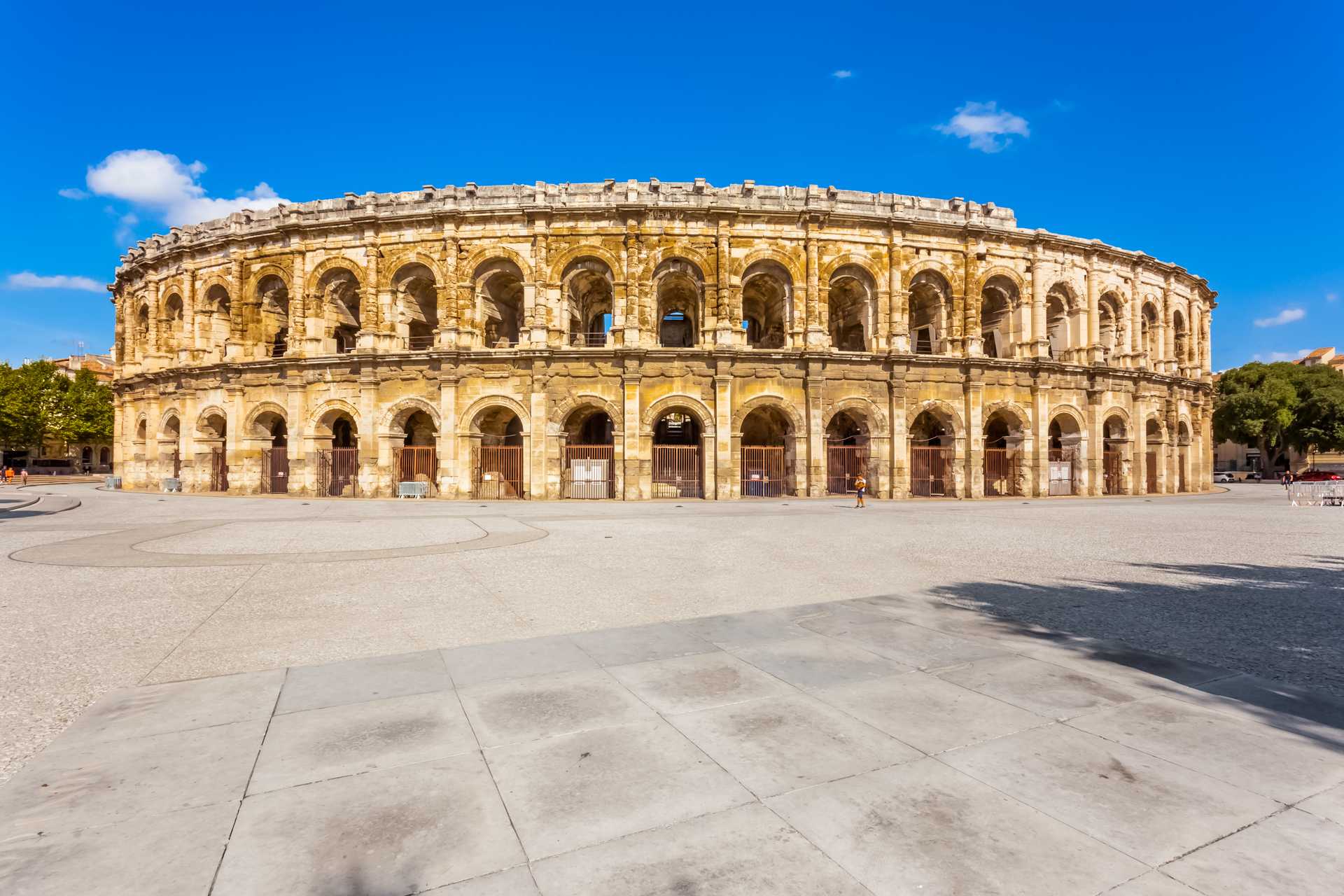
The Arena of Nîmes is one of the city’s most impressive monuments, a genuine Roman theatre in the heart of Nemausus (the ancient name of the city). It was built at the end of the 1st century AD and is 133 metres long and 101 metres wide, with a two-storey exterior façade featuring arcades (60 arches in total) approximately 21 metres high.
In Roman times, more than 20,000 spectators – according to some sources, sometimes as many as 24,000 – could watch gladiatorial combats or animal hunts. Thanks to its remarkably well-preserved structure, the Arena of Nîmes continues to host lively events today: Concerts, historical re-enactments… a vibrant link between the ancient past and the cultural present.
Understanding the history and architecture of the Arena
The architecture of the Arena of Nîmes bears witness to exceptional Roman craftsmanship: the building has a classic elliptical shape with an arena measuring 68 × 38 m, surrounded by stands divided into 34 rows. The public reached their seats via a highly ingenious system of vaulted galleries and radiating staircases, allowing for quick and smooth circulation — a technical feat that is still perfectly visible today.
The exterior façade, consisting of two storeys with arcades, is largely original and was crowned at the time by an attic: one can still see the mounting brackets of a velum, a huge canvas that was stretched above the spectators to protect them from the sun.
Over the centuries, the arena has served various functions: from the Middle Ages onwards, it became a fortress, with dwellings, churches and entire neighbourhoods within its walls.
It was not until the 19th century that the medieval structures were gradually demolished, restoring the monument to its original character. Finally, careful restoration since the 20th century has ensured that the structures have been preserved, in particular by repairing damage caused by weathering and adapting the site to modern use, while respecting its ancient heritage.
Shows, games and cultural events in the Arenas

Nowadays, the performances at the Arena of Nîmes offer a highly varied programme, at the crossroads of ancient history and modernity. One of the most emblematic events is the Grands Jeux Romains, a spectacular event in which around 250 artists from all over Europe re-enact scenes from gladiatorial combats, chariot races, imperial parades and military demonstrations in the arena.
In summer, the arena also hosts the Festival de Nîmes, a series of concerts featuring contemporary music (rock, pop, metal, etc.) in this unique historical setting.

In addition, twice a year the Feria de Nîmes is held, an important event in local culture: the Feria de Pentecôte during Pentecost, the largest and most festive, and the Feria des Vendanges in September, which celebrates the end of summer and the harvest.
Traditional events are organised, known as “courses camarguaises”. In these non-lethal fights, the players must get as close as possible to the bull to try to grab the attributes between its horns – the cocarde, the tassels or the strings – all within a closed arena and within a limited time. The bull is never injured and even becomes a real star when it shows off its agility, speed and temperament. This game, which is deeply rooted in the Camargue and the Gard, is less well known to visitors but remains a strong symbol of local culture and attracts a loyal audience during major regional festivals.
If you have the opportunity, try to attend one of the themed performances in the arena: night-time torchlight processions offer a poetic and mysterious immersion into the Roman world, with stories of gladiators or ancient legends performed in an intimate atmosphere. In summer, sound and light shows bring the arena back to life by projecting images, music and historical symbols onto the stands and the arena itself.
The Arena of Nîmes is therefore not just a witness to the past: it is still alive and transforming into a vibrant stage where spectacle, memories and cultural diversity come together.
The Maison Carrée: a perfectly preserved Roman temple
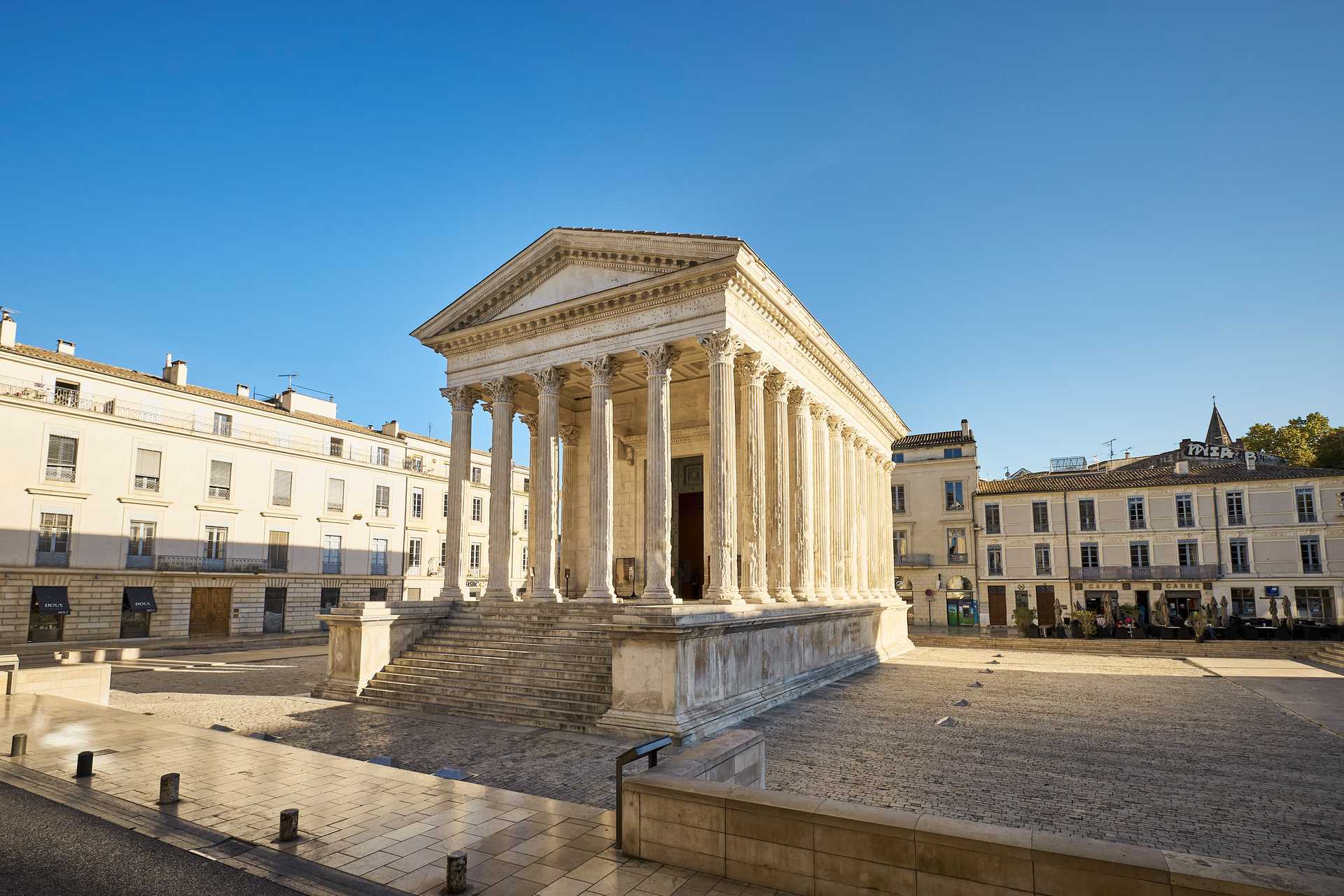
The Maison Carrée is undoubtedly the best-preserved Roman temple in all of Gaul. It was built at the beginning of the 1st century AD and was dedicated to the sons of Augustus, Gaius and Lucius Caesar, the emperor’s heirs. The building stands on the Place d’Assas, in the heart of Nîmes, and is notable for its classic hexastyle layout: six columns at the front, a deep pronaos and a cella at the rear, all resting on a raised podium, as prescribed by Roman architectural traditions.
The building accurately illustrates the art and rigour of Roman architecture: the Corinthian columns, the sculpted pediment and the finely decorated entablature have remained virtually intact over the centuries. Over time, the Maison Carrée has been transformed into a town hall, a church and even a city hall, but it has retained its original structure and is now open to the public as a museum. Permanent and temporary exhibitions provide insight into the history of Nîmes and Rome’s influence on the city, allowing visitors to immerse themselves in antiquity.
The Jardin de la Fontaine: a stroll through the heart of Nîmes’ heritage
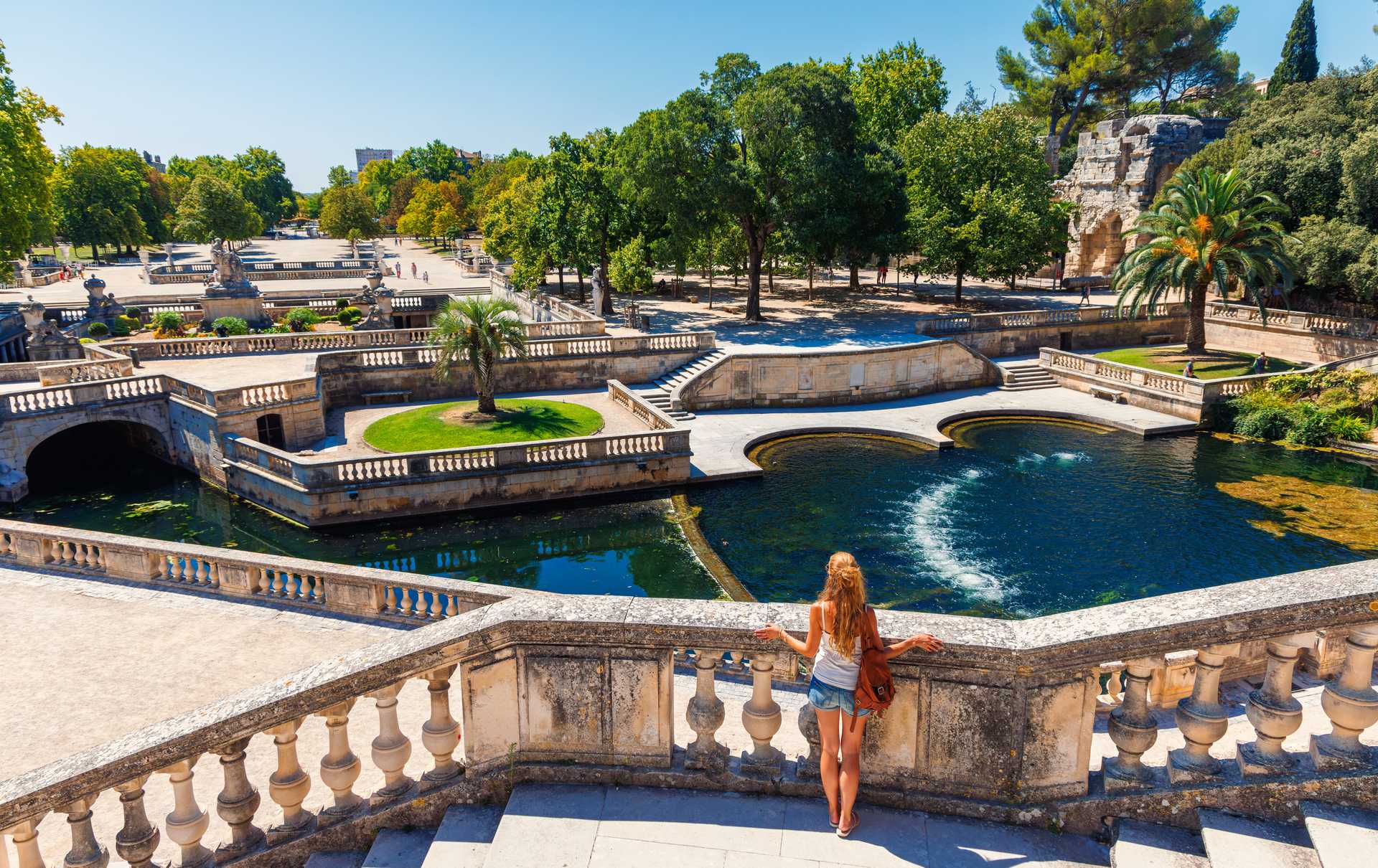
The Jardin de la Fontaine is one of France’s oldest public gardens and an iconic part of Nîmes’ heritage. Created in the 18th century around the ancient spring that supplied the city with water, it covers several hectares and harmoniously combines classical architecture and natural landscapes.
Strolling along its paths lined with statues and ponds, visitors can admire the Roman ruins integrated into the garden, such as the Temple of Diana and the Magne Tower, which dominates Nîmes from the hilltop. The walk offers a perfect balance between nature and history, allowing visitors to discover the history of Nîmes in a serene and bucolic setting. The Jardin de la Fontaine is also a lively place, where concerts, exhibitions and cultural activities punctuate the year, making a visit both educational and enjoyable for all ages.
To visit the Tour Magne, you must be prepared to climb the 140 steps to the top. In the middle of summer, that’s quite a feat ! The Tour Magne is a remnant of the ancient Roman city wall built in the 1st century BC. Today, it offers breathtaking panoramic views of Nîmes and the surrounding area. To accompany your climb, a free audio guide is available, allowing you to discover the legend of François Traucat’s treasure. A unique experience that shows you Nîmes in a different light.
Personal tips from Anca and Philippe

To make the most of your visit to the Arena of Nîmes, allow around 1.5 to 2 hours, combining your visit to the monument with a visit to the small museum that recounts its history and performances. We recommend buying your tickets in advance, especially during the high season, and checking the calendar of events at the Arena of Nîmes to see if you can attend a reconstruction or concert. Be sure to wear comfortable shoes, as although the arena and stands have been restored, they are still made of stone and can be slippery in wet weather.
After visiting the amphitheatre, take a stroll through the historic centre to discover other sights: the Maison Carrée, the Jardin de la Fontaine and the Tour Magne offer a pleasant walk rich in history. Don’t hesitate to stroll through the narrow streets to admire the old façades and lively squares, or to enjoy a moment of relaxation on a terrace.
To complete your day, the Musée de la Romanité, located opposite the arena, offers a modern and interactive immersion into the history of Nîmes. Housed in an ultra-modern building, the Musée de la Romanité is a gigantic structure of glass and steel that catches the October sun and contrasts strikingly with the Nîmes arena. Children actively participate in the visit. In this museum, history is not just a story from the past, but a living adventure, a bridge between eras and a fun discovery for the whole family !
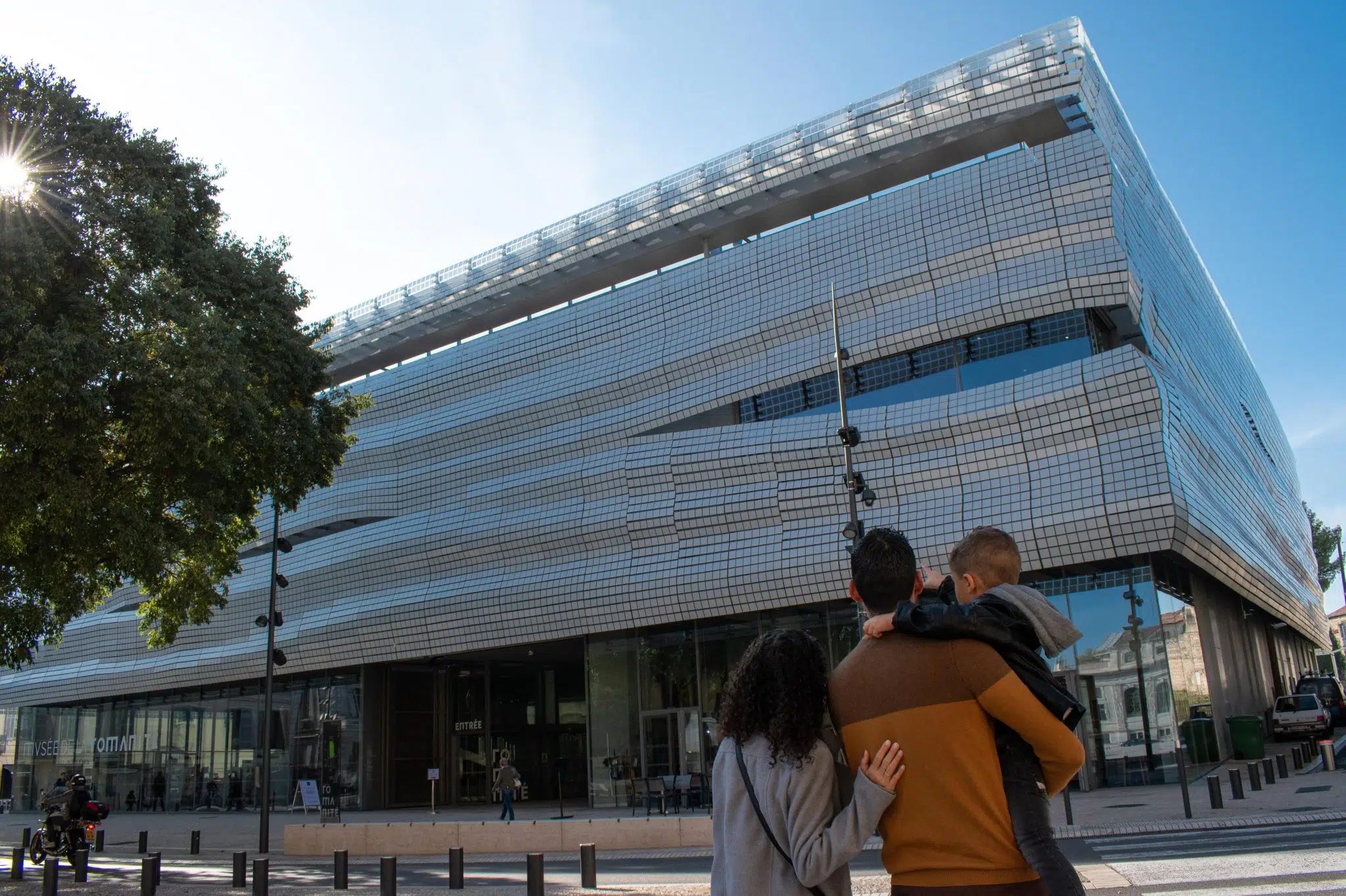
Nîmes shows us all the colours of the rainbow ! For several years now, Street Art has been an integral part of the cityscape of Nîmes! Be sure to explore the murals that adorn the walls of the Richelieu and Gambetta neighbourhoods. Look up, stroll through the alleys and lose yourself in these two working-class neighbourhoods that are really worth a detour !
Learn more : https://nimes-tourisme.com/actualites/a-la-decouverte-du-street-art-a-nimes-et-ses-alentours/
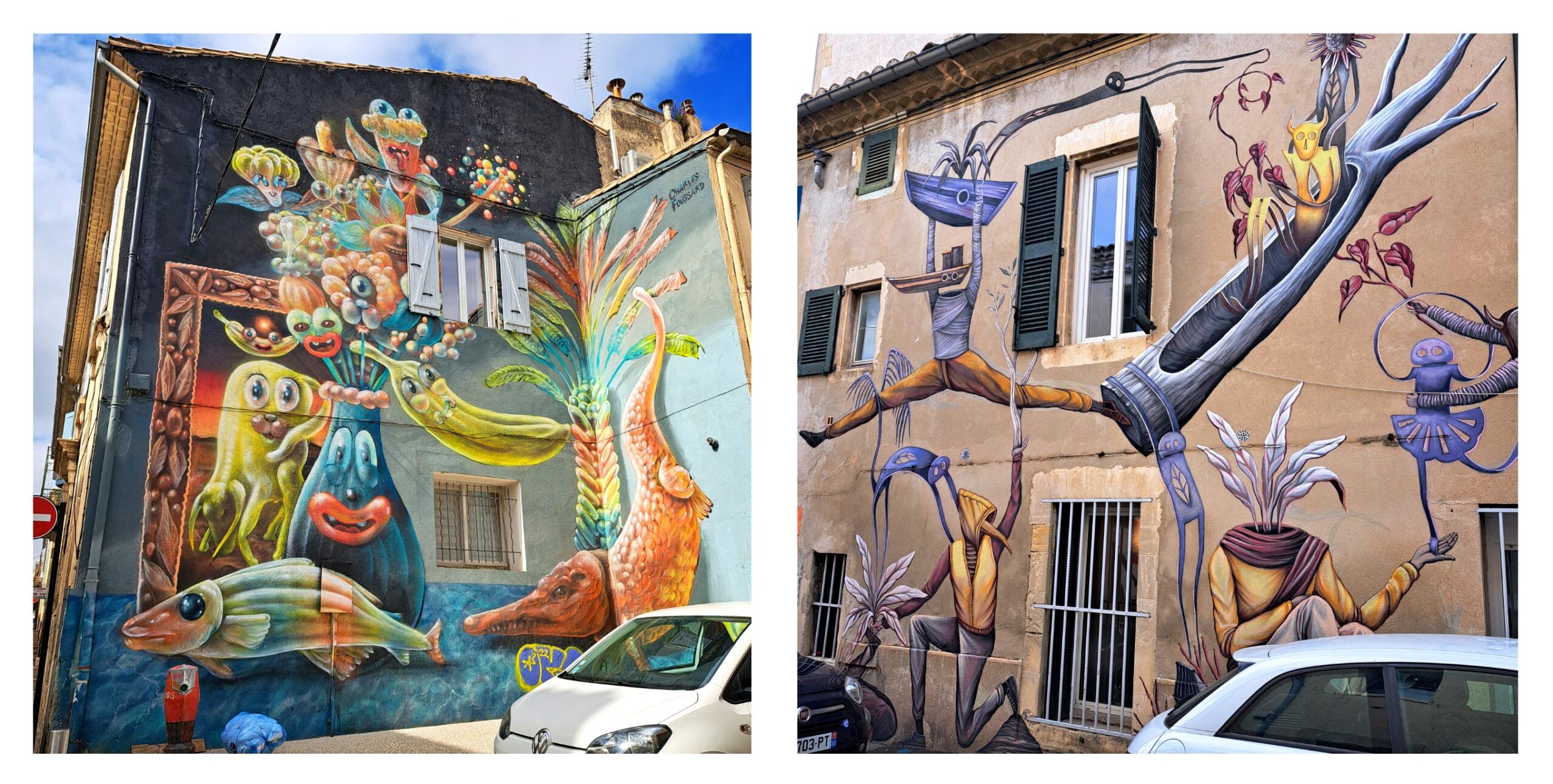
Finally, don’t forget to bring water and a sun hat in summer, as Nîmes can be very sunny. It is best to visit the city early in the morning or late in the afternoon to avoid the heat and crowds.
As for parking in Nîmes, there are numerous underground car parks. To plan your visit, visit the website www.nimes-stationnement.fr/stationnement/, which shows all car parks and the number of spaces available in real time.
On the way back, stop at the Pont du Gard to admire this exceptional site and cool off on the banks of the Gardon. Admission is free – parking costs 9 Euros per car – and you can access the beaches that overlook the iconic Roman aqueduct. This is probably one of the most unusual places to swim !

A visit to Nîmes from our holiday home
For those who want to discover Nîmes while enjoying a quieter environment, our holiday home near Nîmes is ideal. Our holiday home is only 60 km away, an hour’s drive from Nîmes, perfect for a day trip.
From our Moulin de Souchieres, you can plan a daytrip to Nîmes: visit the arena, stroll through the historic centre, explore the Maison Carrée and the Jardin de la Fontaine, and on the way back, stop at the Pont du Gard for a refreshing dip in the Gardon.
Thanks to our central location, you can make the most of your holiday in the Vaucluse, combining the rich heritage of Nîmes with the Provençal landscapes and charming villages of the region. Alternate cultural day trips with moments of relaxation and tranquillity in a rural setting, discovering the city’s main attractions from a delightful country house in Provence.
To continue your exploration of Roman history, you can also visit the nearby town of Orange with its ancient theatre and triumphal arch, or Saint-Rémy-de-Provence and the archaeological site of Glanum, a beautifully preserved ancient Roman oppidum. After your daytrip, come back and relax in the garden and swimming pool of your holiday home in the Vaucluse.
Discover all our articles on the picturesque villages and historical sites of Provence on the Moulin de Souchières blog, along with many other publications that will help you plan the perfect holiday with us !
Useful information about Nimes
- Website tourist office : https://nimes-tourisme.com/
- Website Arènes de Nîmes : https://www.arenes-nimes.com/
- The Media of the City of Nîmes : www.vivrenimes.fr
- Website Maison carrée de Nîmes : https://www.lamaisoncarreedenimes.fr/accueil
- Website Musée de la romanité de Nîmes : https://museedelaromanite.fr/
- Parking information : https://www.nimes-stationnement.fr/stationnement/
Map :

